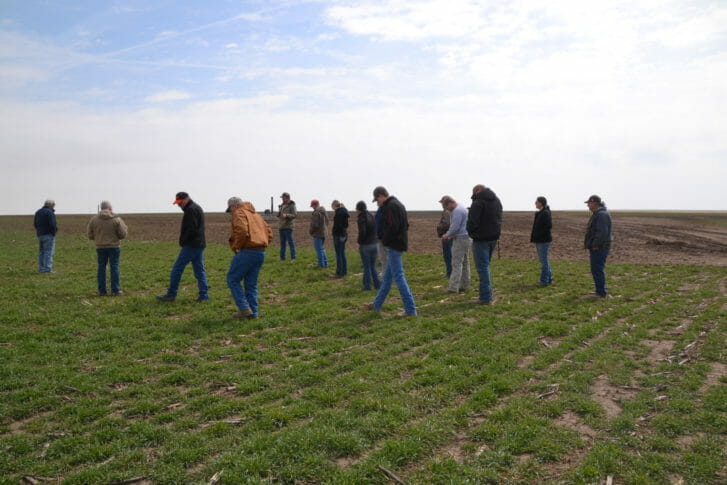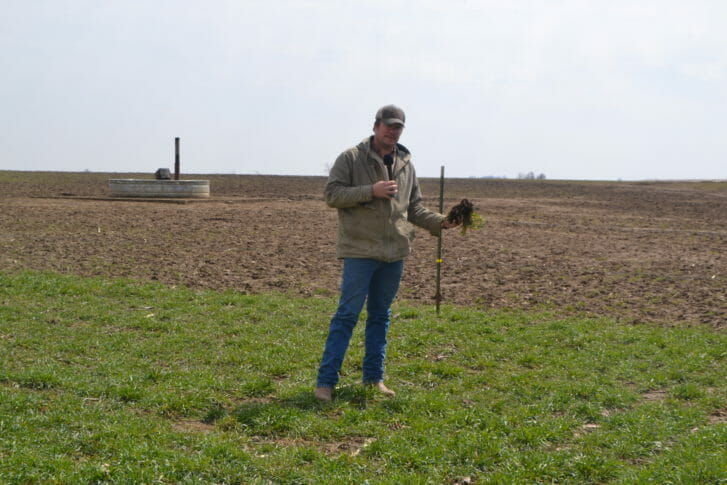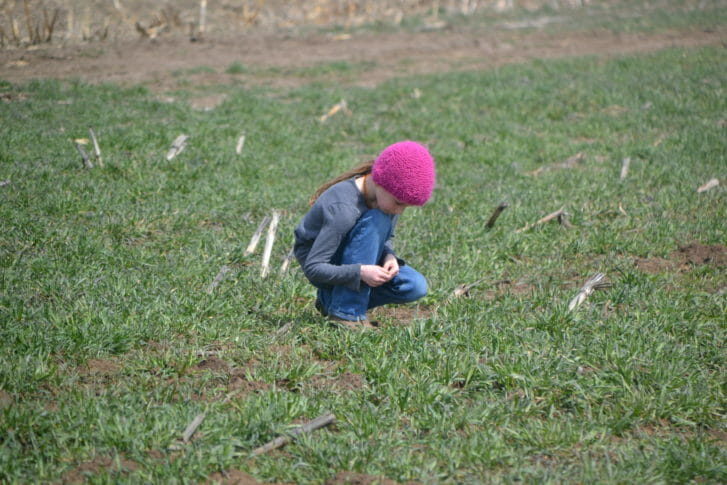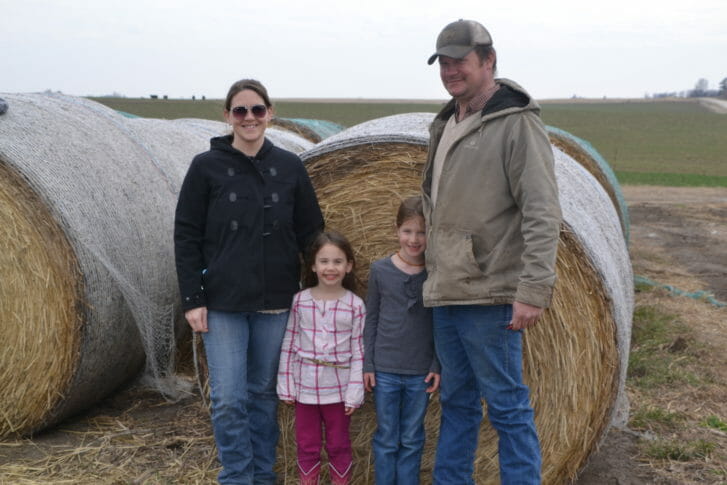Field Day Recap: Grazing Cover Crops – Zak Kennedy
The sixth field day in our 2018 Cover Crop Caravan series, was hosted by Zak Kennedy on April 5 in Atlantic. Cover crops were greening up in southwest Iowa and 25 people came out to hear Zak Kennedy talk about how he integrates cover crops into his cattle feeding operation. Zak, his wife Emily and brother Mitch, operate Kennedy Cattle Co., in Cass county. They background cattle from all over the U.S. and have found that using cover crops as a feed source provides profits, among other benefits. As a cattle farmer first, and crop farmer second, the focus of this field day was on the livestock.

Field day attendees walk through Zak Kennedy’s cereal rye fields on April 5, 20118.
Crop crops and livestock pencil out
Zak first tried planting cover crops in 2012. Since then, he’s grazed them, chopped them and baled them. Over the years, he has grazed heifers, steers and cow-calf pairs on covers throughout the fall, winter and again in the spring. At times, he didn’t have to feed them anything other than the cover crops. This translates to money saved. Zak provided the group with numbers from grazing this last year.
Fall 2017:
- Zak turned out 125 steers weighing 850 pounds on 45 acres of cereal rye
- He didn’t feed them for 18 days, saving $2 per head per day
- This adds up to $250 dollars a day in savings, which equals $4,500 in savings over 18 days
- Cover crop seeding cost $25 per acre on 45 acres; which equals $1,125
- $4,500 in feed savings – $1,125 in seed costs = $3,375 savings
Spring 2018:
- 22 cow-calf pairs were turned out on cereal rye for 21 days
- Some supplemental feed was provided to them, so savings totaled $1 per head per day
- This adds up to $22 dollars a day in savings, which equals $462 in savings over 21 days
- The seeding cost was accounted for prior; Zak got a second grazing out of the same cereal rye this spring
- An added benefit is the clean pasture provided for cows to calve on, and avoiding the trouble that mud creates for newborn calves

“I like seeing these roots and this soil aggregation,” said Zak, holding a clod of soil growing cereal rye.
Benefits of grazing
Not only does grazing cover crops keep money in Zak’s pocket, but he’s been happy with how his animals preform and look when they’re given the opportunity to graze. “I see a lot less health issues when animals are out on fields versus in an a half acre lot,” said Zak, who said that grazing covers helps to clean and shine steers up. “You’re selling a look and a buyer will give you more for healthy appearing animals.” Zak said cover crops make his steers look like wheat steers and he’s received top dollar at the sale barn for them.
Decent average daily gains are achievable too. A group of 125 head of backgrounders gained close to 2 pounds per day. “Another nice thing is cattle will spread manure for you too,” added Zak.
Rye hay, ryelage
To make dry rye hay, “You need a heck of a long window without rain,” said Zak, who successfully baled rye in 2017. Rye was baled 10 days after chopping. Zak uses bales of rye as a feed stretcher or as bedding.

Zak leans on a bale of cereal rye hay that was baled in May 2017.
As for ryelage, Zak shoots for harvesting in late May, and has produced 10 tons per acre. He grinds the bales and feeds them out soon after. Last year, he wasn’t confident with the pack they got on the wet rye, so it was fed during the summer when they had lots of backgrounders to feed. Zak said he wishes they would have inoculated it and tried wrapping because he knows there are quite a few bale wrappers around the area to use.
2018 plans
Zak explained some changes he plans to implement this coming growing season.
- He won’t plant green to corn (which he saw yield decreases from last year)
- He wants to create more feed opportunities to save more money by planting shorter season corn and get on custom driller’s list to drill as soon as silage is harvested
- He wants to figure out how to back off fertilizer rates through quantifying what manure is providing
Zak’s parting message for the day was, “If a farmer can incorporate livestock into cover crops, it’s hard to deny that it works.”

Cassidy Kennedy, daughter of Zak and Emily, inspects a field of cereal rye during the field day.

Emily, Cadence, Cassidy and Zak Kennedy of Kennedy Cattle Co. in rural Atlantic, Iowa.
Thank you to the Kennedy family for opening up your farm and to the Cass County NRCS team for conducting soil health demonstrations. Thanks to the Iowa Department of Agriculture and Land Stewardship for funding this event.
